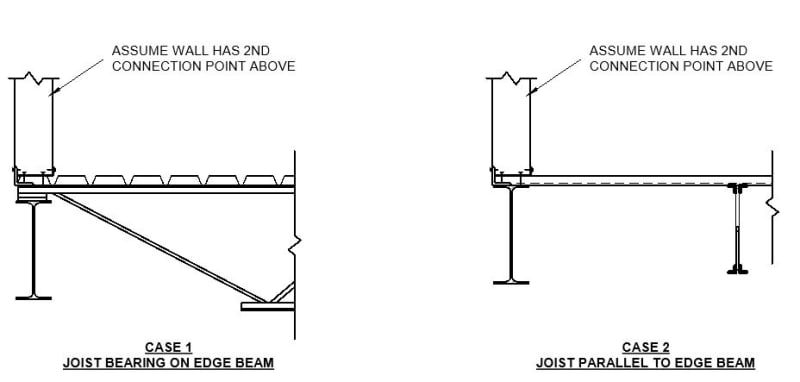MJC6125
Structural
- Apr 9, 2017
- 120
See image below for two similar conditions. They are both for a CFS non-load bearing wall sitting on the edge of a low roof at a roof step. One is when we have steel joists bearing on the edge beam, and one is where the edge beam is parallel to the joists. I have a few questions related to these details.

1. For case 1, do you automatically need to have an edge angle of some sort to fasten the edge of your diaphragm to? I think the answer is yes or some sort of blocking pieces between each joist.
2. For case 2, would you use an edge angle like shown or is that unnecessary because the steel beam is what the deck is fastened to and the beam can act as your diaphragm chord/collector?
3. Assuming this is a non-load bearing wall with no brick veneer, are you OK with setting the studs directly on the metal deck or do you stop the metal deck to the right of the wall and sit the wall directly on structural steel?
4. Does the vertical leg of the edge angle create an access issue for screwing the bottom track to the studs at the base of the CFS wall? Is that an issue that needs to be remedied or would the contractor build the wall on the ground first and then set it in place and fasten down the bottom track?
I know roof flashing and architectural considerations may play into these details, but I wanted to see if anybody had preferences on what they do structurally.

1. For case 1, do you automatically need to have an edge angle of some sort to fasten the edge of your diaphragm to? I think the answer is yes or some sort of blocking pieces between each joist.
2. For case 2, would you use an edge angle like shown or is that unnecessary because the steel beam is what the deck is fastened to and the beam can act as your diaphragm chord/collector?
3. Assuming this is a non-load bearing wall with no brick veneer, are you OK with setting the studs directly on the metal deck or do you stop the metal deck to the right of the wall and sit the wall directly on structural steel?
4. Does the vertical leg of the edge angle create an access issue for screwing the bottom track to the studs at the base of the CFS wall? Is that an issue that needs to be remedied or would the contractor build the wall on the ground first and then set it in place and fasten down the bottom track?
I know roof flashing and architectural considerations may play into these details, but I wanted to see if anybody had preferences on what they do structurally.
